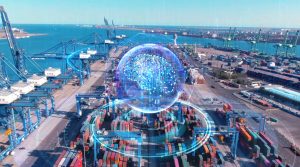Smart & Green Ports
India has a dream of its 12 seaports ,some more then 50 years old, becoming maritime hubs and globally recognised manufacturing hubs. No doubt its seaports handled cargoes slightly in excess of 700 million tonnes in the fiscal year 2020. To this end India plans to upgrade its port infrastructure by investing $ 5-6 billion annually. In order to unlock the economic potential of any maritime nation and to achieve the next stage of economic growth digital technology and adoption of artificial intelligence is essential.
 Courtesy National Sagarmala Apex Committee
Courtesy National Sagarmala Apex Committee
Attracting lines
It goes without saying that ports have to become efficient in cargo handling and cost competitive in terms of freight, bulk and container handling, optimizing shrinking yard space due to increased cargoes and achieving high turnaround time.Shipping lines are attracted to smart ports.
Green ports
 Courtesy Port of Long Beach
Courtesy Port of Long Beach
The International Maritime Organization (IMO) is emphasizing on using fuel with low carbon emissions, generating energy from renewable sources, marine conservation , safer operations, automation of cranes, water recycling plants, drones to carry out certain tasks, milli second lever control over information pathways enabled by programmable logic controllers ,digitisation of traffic data and sensor technologies and operations. The 12 seaports have more then 250,000 acres of prime estate in their jurisdiction. Kandla Port may be the first smart port to be developed with a contiguous special or export processing zone ,ship building yards and a smart city to cater to the ports requirements evolving around it.
Digital initiatives
India’s Sagarmala programme aims at constructing ports , creation of infrastructure and logistics accompanied by the latest digital technology and the initiative will support and supplement the coastal economy as well . The country has an advantage of 750 million smartphone users and low data network costs. The Sagarmala programme embraces 802 projects and new port and infrastructure is to be built at a cost of almost Rs 65,000 million. The legacy of WIFI and physical interconnecting cable networks will fade out and 5G cellular technology introduced with the payback period hovering between 3-5 years. The initiative envisages a transparent and paperless regime. Estimates are that in the last 8 years the cargo handling has increased by almost 40 % or 80 million tonnes and employment increased by 10 million.
Port of Barcelona
To optimize cargo and shipping traffic the Port of Barcelona has adopted ICT communication platform of PORTIC. The Hamburg Port avails a cloud based information system and application known as smartPORT logistics.The Port of Amsterdam business model revolves around its proximity to the Amsterdam Airport Schiphol utilizing a digital port to airport logistics interface.
China’s intelligent ports
 Courtesy Huawei Cloud
Courtesy Huawei Cloud
In a space of 33 months a fully automated and zero carbon terminal was constructed at Tianjin Port and the employees deployed were 60 % less then those at a traditional terminal. The Port of Qingdao adopted digital technology which witnessed an increase in anchorage rotations of very large and ultra large container ships container ships. The ports of Singapore and Shenzhen propose to conduct cross border transactions digitally and have achieved critical collaboration in using digital Bills of Lading.

Leave A Comment